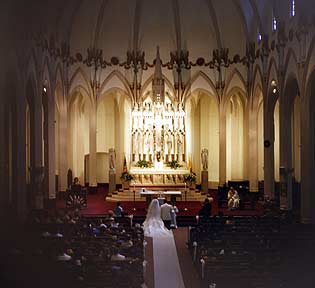
Tutorial and Guide to Selecting Wedding Music
Information included on this page:
- Quickstart Guide
- Wedding Music Information - an overview
- Selecting the actual music repertoire
- General Outline of a Typical Ceremony
- Pieces to Consider Carefully Before Using (i.e., not recommended for various reasons)
- Terms & Conditions (contract with your own wedding musician: overtime charges, extras, etc.)
Quickstart Guide (the easiest choices!)
If you would prefer to use the most common pieces, consider those below, which are some of the best selections that would be most fitting for a wedding ceremony (religious or not) and would not stir up any "controversy" (these also work well for trumpet & organ).
We present a category of "Quickstart" pieces
when you start the actual music selection process.
- Prelude music - we suggest to leave it to your musicians to select appropriate music for the seating of the guests - they are experts and know what fits the mood best during the arrival of your friends and families.
- Seating of the parents - Pachelbel: Kanon in D (slow, soothing, meditative)
- Processioinal - Purcell/Clarke: Trumpet Voluntary in D (stately, appropriately festive & joyful)
- Recessional - Beethoven: Ode to Joy (energetic, happy)
The sections below describe the process for selecting wedding music and some additional suggestions.
Wedding Music Information- an overview
A Summary of Wedding Music Information
Modern Western Weddings
During the service there may be a few places for music, especially in liturgical settings. Optional solos and a short piece for the lighting of the Unity Candle may also occur. At the end of the service, the bride and groom march down the aisle to a lively recessional tune, the most popular tune having been Mendelssohn's Wedding March from A Midsummer Night's Dream (1826) which had been popular in the last half of the twentieth century, but is falling out of favor with current wedding styles. A current popular choice is Widor's Toccata from Symphony No. 5 (1880), or a variant on Beethoven's Symphony 5 "Ode to Joy" (last movement). The ceremony concludes with an instrumental postlude as the guests depart, which may be an extension of the recessional or it may be one or more additional lively pieces. |
There are four basic areas for music in the wedding ceremony—these are detailed in the click-to-view web page below. There is no one set ceremony order of service, so feel free to sculpt yours to have the feel that suits you and your situation the best.
- Prelude (Pre-service) music, while the guests are arriving (music provides a nice backdrop for the time while your family and friends gather and visit and are being seated)
- Processional (entrance of the officiant(s) and wedding party)
- Ceremony Music within/during the actual ceremony (readings, homily/remarks, vows, pronouncement)
- Recessional (exit of the wedding party, families, and guests)

Copyright ©2007 Will Sherwood
Italics represents optional musical choices
PDF Version
As you're browsing through the lists of titles from our site, below are some aspects you’ll want to be aware of for the music that best fits your service:
- Overall style & mood of the music
- Classical and/or religious
- Mood/emotions desired: festive, meditative, high church, secular
- How the music
fits with the goals and style of the overall ceremony. For instance, some
want to emphasize brevity (as short as possible), others want a musical
concert, some would like the music to support and highlight a few of the
spoken parts.
- Primary instrument(s)
- Typically pipe organ (if in a church or concert hall)
- Other choices: harp, classical guitar (acoustic), string quartet, brass quartet, woodwind quintet, orchestra
- Additional instruments or vocal solos (i.e., the pipe organ (or piano) can accompany an additional solo instrument or voice
- Trumpet, flute, voice, etc. can be used to add variety and a festive mood in any or all times of the ceremony
Selecting the actual music repertoire
After you select your titles, your organist or musician may discuss with you the music you’d like performed. Sometimes due to the venue, particular instrument, or other restrictions, some titles may not be possible to have performed, and your musician will help you find a similar piece that is possible.
We begin with the selection of the processional (and recessional). In the mid 20th century, the standard processional was the Bridal Chorus by Wagner ("Here Comes the Bride"), and the recessional was Mendelssohn’s Wedding March from Midsummer Night’s Dream. Around 1970, people began shifting the music selections for weddings (as well as many other aspects), such that it became more contemporary and meaningful. Many of the spoken sections of the ceremony were updated to be non-sexist and stated in modern English. Too, many looked at the origins of the previously traditional wedding music and disliked the underlying themes that they represented (intended or not), not to mention the commercialized usage of the music on TV and in the movies.
For the processional, you will want to pick a style: fanfare, stately, meditative/quiet, etc. If there are a large number of attendant & usher people, you may want to consider two (even three) pieces for the different groups of people entering (see the timeline diagram above). For a medium-sized wedding party, the officiants (ministers/jp, rabbi, clergy, etc.), groomspeople, bridal attendants, and flower/ring people would process to one piece, and the bride and her escort (if one) would process during a second piece.
You would choose the processional first, and pieces that "placed second" might be candidates for the recessional, and then remaining pieces (as well as additional ones) that you liked (but not as a processional) could be considered for the prelude music (but played less energetically!).
There is no right or wrong way to create the order of service for the ceremony. You’ll be discussing this with your officiant, and s/he will usually have guidance about their standard sequence of events. We’re all here to customize the service as you desire, and help coach you, based on our experience, for specific pieces or a sequence of items in the service that might not work well.
In a recent wedding, the minister insisted that he and the groomsmen and groom assemble silently, and then for me to begin the processional music for the bridesmaids and bride. Although I commented that I felt this would be awkward, I complied with their wishes. After the service, two people commented to me wondering "What happened?" at the beginning of the processional-- they thought I had missed the cue to start playing.
If you’re having the ceremony videotaped, please ensure that your videographer has all the proper musician and copyright releases needed (this is your responsibility). And as a courtesy to the musicians (and to avoid a catastrophe!), please ask all flash photographers not to shoot into the eyes of the musicians while they are playing.
A few years ago I played a wedding in Acton where they wanted me to switch to piano for a special solo during the ceremony. Out from nowhere, the wedding photographer appeared and took a flash picture (standing 10' from me). Not only was I startled but it took some ten seconds for my eyes to readjust. Fortunately, I knew the music well enough to continue without causing an embarrassing improvisational side trip.
General Outline of a Typical Ceremony
Organ Prelude (begins about 20 minutes before the announced time of the wedding; people are being seated during this; the last to be seated are the families/parents; if there’s an aisle cloth (a.k.a. runner), it’s "pulled" (deployed) after the families are seated- you may want to select special pieces for the seating of the families, etc.) Ringing of the Church (Tower/Steeple) Bells (optional) Processional (officiants, groomspeople/ushers, bridespeople, flower/ring people,
bride+escort) Welcome Silent Prayer Introduction Congregational Hymn (optional) Scripture or other readings Music meditation (optional) Homily Lighting of
the Unity Candle Vows Exchange of Rings Vocal Solo (optional) Prayer Pronouncement (By the powers vested,… I now pronounce you…) Presentation to the congregation (I present to you Mr. and Mrs….) Recessional |
Pieces to Consider Carefully Before Choosing...
Bridal Chorus (Lohengrin)- The traditional wedding processional "Here Comes The Bride" is from the opera Lohengrin by Richard Wagner. In the opera, the relationship between Elsa and Lohengrin was doomed because of a broken promise. Former tradition (1920s - 1960s) dictates that it was acceptable to use "Here Comes The Bride," however, you may wish to consider the numerous alternative processional selections due to these negative connotations (and overuse/commercialization/ridicule of the piece).
One Hand, One Heart (West Side Story) – sung prior to the killings and gang fights
Godfather’s Waltz (The Godfather)– Played before the groom gets blown up in a car
Wedding March (Midsummer Night's Dream) – some people avoid this common selection because it’s a part of an illicit bedroom scene; also it’s used commercially in toothpaste commercials, etc.
The Wedding Song – musically not great (melody is primarily one note), and the words need to be edited not to be sexist.
I Think I Love You – too tentative
Pavanne for a Dead Princess (Ravel) - A stately procession/dance of mourners trapped within the bounds of court etiquette.
You will want to understand the "terms and conditions" for contracting wedding musicians. It would be rare to encounter a problem since the music community is comprised of trained and experienced professionals who have been affiliated with churches and universities typically for long periods of time. However as with any monetray transaction, it's advised to have the agreement and unexpected possibiilties in writing. Below is a link to an usually detailed, but still somewhat typical "fine print" for the terms of engaging a musician's services. We present this here as a matter of thoroughness so that you will be aware of questions to ask your musician how they handle various infrequent situations.
Click here to read a sample (but detailed) Terms and Conditions.
